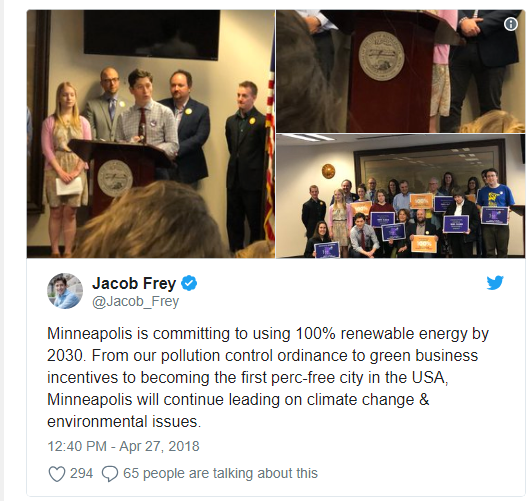Minneapolis Becomes 65th U.S. City to Adopt 100% [Fraudulent] Renewables Goal
Minneapolis City Council and Mayor Jacob Frey announced Friday the city’s pledge to achieve 100 percent renewable electricity for municipal facilities and operations by 2022 and citywide by 2030.

According to EcoWatch, the measure was approved unanimously by the City Council, with the council claiming the resolution was crafted in response to the threat of climate change that is caused primarily by the combustion of fossil fuels.
Here are three reasons why this pledge is an expensive fraud:
1. The City of Minneapolis won’t actually run on 100 percent renewable energy.
Unless the City of Minneapolis plans on running on hydroelectric power, there is no way the city could possibly run on 100 percent renewable energy.
This is because wind and solar can only produce electricity when the wind is blowing or the sun is shining. As a result, the City of Minneapolis will continue to purchase their electricity from the grid, which is mostly powered by the same coal, nuclear plants that have provided power to the city for decades, along with smaller contributions from wind, natural gas, and solar.
In order to meet their claim of 100 percent renewable, the Minneapolis will most likely purchase Renewable Energy Certificates (REC’s).
Renewable Energy Certificates are just a “creative accounting” mechanism that allows for the sale of renewable energy credits.
According to David Roberts from Vox:
“When a renewable energy generator — a wind farm or solar power plant, for example — generates a megawatt-hour (MWh) of power, it creates two sources of value. It creates electricity, which it can sell at prevailing market rates. And under federal law, it receives one REC, a certificate saying that it generated one MWh of electricity from clean sources…”
“Once you’ve got a system of RECs established, you make it possible to buy green electricity. You just buy some electricity (from anywhere), buy the same amount of greenness (in the form of RECs), and boom, the electricity is green.”
In essence, the City of Minneapolis will not actually be buying green energy, they will just be buying the piece of paper that is associated with a given megawatt hour of renewable energy produced somewhere throughout the country.
This simply means businesses and families will have to pay more money in taxes so the city can purchase the same electricity they would have bought anyway.
2. This measure will make electricity more expensive for the city, adding unnecessary costs for taxpayers.
The extra cost of the RECs will probably not be absorbed by reducing the pay of Mayor Frey or the City Council members, (who recently voted themselves $10,000 raises) so it will be passed on to taxpayers.
In fact, Minneapolis is already paying a premium for electricity because it has entered into similar agreements to purchase renewable energy. These agreements have resulted in the City paying an extra 6 to 12 percent for the electricity they purchase from renewable sources.
Increasing the amount of electricity purchased from renewables will only add to the extra cost. Here’s how it might look:
Let’s pretend Minneapolis buys their REC’s from the Bonneville Environmental Foundation for $8 per megawatt hour.
The city government of Minneapolis uses about 90,000 megawatt hours of electricity per year. This means the city would be paying an extra $720,000 dollars ($8 x 90,000=$720,000) for the same electricity they would have purchased anyway, but now there is an REC associated with it.
3. The amount of carbon dioxide offset by this measure would be globally irrelevant.
Even if the entire United States were to comply fully with President Obama’s Clean Power Plan, it would only have averted 0.019 degrees C of potential future global warming, according to the climate models used by the previous administration.
0.019 degrees C is an amount too small to be accurately measured with the most sophisticated scientific equipment.
This means that Mayor Frey and the members of the City Council are asking Minneapolis taxpayers to pay an extra $720,000 per year for a policy that is utterly irrelevant to global temperatures.
Conclusion
The claim 100 percent renewable energy is incredibly misleading because the government buildings in Minneapolis will still be mostly powered by coal and nuclear plants, but citizens of the city will get to pay more in taxes so the mayor and city council members can pose for pictures and pat themselves on the back for “being green.”
We ought to ask our public officials tough questions like, “How will purchasing REC’s from distant renewable electricity sources reduce pollution in Minneapolis?” and “Why are we paying more for the electricity used at city buildings when we could be putting that money toward schools or programs for the elderly?”
Hopefully Mayor Frey and the City Council are open to discussing these policies and allocating resources to more worthwhile pursuits.